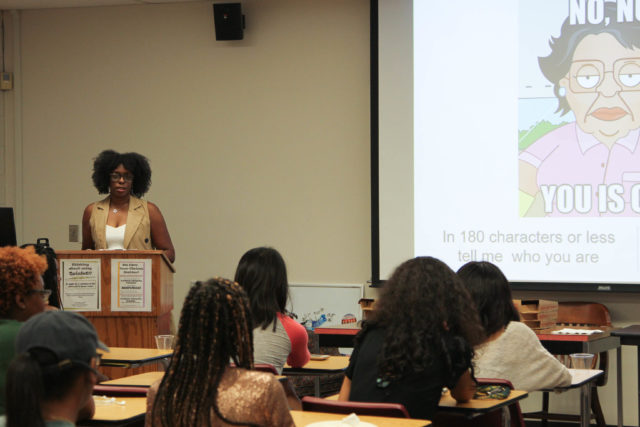By Maya Butler | Reporter
It seems as if the trend has been to trade in the traditional newspaper for social media apps in search of the latest news, according to a 2017 study done by Pew Research Center, which found that “two-thirds of U.S. adults get news from social media.”
The National Association of Black Journalists held their first meeting of the school year at 6:30 p.m. on Thursday in Castellaw.
Kennetta Piper, CEO and founder of The Birthing Point, a site which offers project management and professional coaching services for personal or business settings, was the guest speaker.
The topic — Twitter, and its impact on journalism.
Piper, who holds a Master of Science in mental health counseling and a Bachelor of Science in broadcast journalism, discussed the new roles of those in the news industry as a result of social media like Twitter.
“Journalists are coordinators, they’re no longer gatekeepers,” Piper said. “Back in the day, news reporters were the only people that held the information, but now, we’re just coordinators.”
Piper went on to clarify the relationship between the popular social media platform and journalism.
“Twitter is not something to be looked at as a threat,” Piper said. “There are ways to use Twitter to your benefit, even if you are a traditional journalist.”
Her presentation included the effectiveness of applying relevant hashtags, thinking before sending out a Tweet and the importance of confidently defending information posted on personal accounts.
During her talk, Piper said that Twitter currently holds around 330 million monthly active Twitter users, and 550 million tweets are posted per day.
Irving junior Kristina Valdez explained her thoughts on how she perceives news posted on Twitter.
“I think it keeps me more aware of other people’s opinions and how other people perceive the news,” Valdez said. “I might just read it one way, but someone else can take it a totally different way. Reading it on Twitter also kind of creates a community about what people are talking about if anyone wants to know, and so I think it’s very important.”
Over the years, Twitter has spawned several movements that have brought national attention to social problems through the use of popular hashtags, including #MeToo, #OscarsSoWhite and #BlackLivesMatter.
Piper showed a chart that displayed the growth of the #BlackLivesMatter movement, which began in 2013 in response to the killing of black 17-year-old Treyvon Martin.
“That’s how quick a movement can take place when there are people on the ground that know the stories, that are reporting the stories,” Piper said.
After the conclusion of the meeting, Austin sophomore Na’Caesa Pink talked about the main point she took from the presentation.
“Twitter is a tool when you use it to its full potential,” Pink said. “Don’t let it hurt you. Don’t be afraid of it. Embrace it, and use it to meet new people, reach new people, and find new information. Like she [Piper] said, news travels really quickly, and Twitter is probably, out of all the social media, the fastest site for that.”



